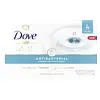What's inside
What's inside
 Key Ingredients
Key Ingredients

No key ingredients
 Benefits
Benefits

No benefits
 Concerns
Concerns

 Ingredients Side-by-side
Ingredients Side-by-side

Sodium Lauroyl Isethionate
CleansingStearic Acid
CleansingSodium Oleate
CleansingSodium Stearate
CleansingWater
Skin ConditioningSodium Isethionate
CleansingLauric Acid
CleansingSodium C14-16 Olefin Sulfonate
CleansingSodium Laurate
CleansingParfum
MaskingBenzalkonium Chloride
AntimicrobialDipropylene Glycol
HumectantSodium Chloride
MaskingTetrasodium Etidronate
Emulsion StabilisingTetrasodium EDTA
Titanium Dioxide
Cosmetic ColorantCI 42090
Cosmetic ColorantCI 19140
Cosmetic ColorantSodium Lauroyl Isethionate, Stearic Acid, Sodium Oleate, Sodium Stearate, Water, Sodium Isethionate, Lauric Acid, Sodium C14-16 Olefin Sulfonate, Sodium Laurate, Parfum, Benzalkonium Chloride, Dipropylene Glycol, Sodium Chloride, Tetrasodium Etidronate, Tetrasodium EDTA, Titanium Dioxide, CI 42090, CI 19140
Benzoyl Peroxide 4%
Carbomer
Emulsion StabilisingDecyl Glucoside
CleansingDimethicone
EmollientDiheptyl Sodium Sulfosuccinate
CleansingGlycerin
HumectantPalmitic Acid
EmollientPolyacrylate Crosspolymer-6
Emulsion StabilisingPEG-40 Stearate
EmulsifyingPropanediol
SolventWater
Skin ConditioningSilica
AbrasiveSodium Chloride
MaskingSodium Citrate
BufferingSodium Hydroxide
BufferingSodium Laurylglucosides Hydroxypropylsulfonate
CleansingSorbitan Stearate
EmulsifyingSorbitol
HumectantStearic Acid
CleansingT-Butyl Alcohol
PerfumingXanthan Gum
EmulsifyingBenzoyl Peroxide 4%, Carbomer, Decyl Glucoside, Dimethicone, Diheptyl Sodium Sulfosuccinate, Glycerin, Palmitic Acid, Polyacrylate Crosspolymer-6, PEG-40 Stearate, Propanediol, Water, Silica, Sodium Chloride, Sodium Citrate, Sodium Hydroxide, Sodium Laurylglucosides Hydroxypropylsulfonate, Sorbitan Stearate, Sorbitol, Stearic Acid, T-Butyl Alcohol, Xanthan Gum
 Reviews
Reviews

Ingredients Explained
These ingredients are found in both products.
Ingredients higher up in an ingredient list are typically present in a larger amount.
Chances are, you eat sodium chloride every day. Sodium Chloride is also known as table salt.
This ingredient has many purposes in skincare: thickener, emulsifier, and exfoliator.
You'll most likely find this ingredient in cleansers where it is used to create a gel-like texture. As an emulsifier, it also prevents ingredients from separating.
There is much debate on whether this ingredient is comedogenic. The short answer - comedogenic ratings don't tell the whole story. Learn more about comegodenic ratings here.
The concensus about this ingredient causing acne seems to be divided. Research is needed to understand if this ingredient does cause acne.
Scrubs may use salt as the primary exfoliating ingredient.
Learn more about Sodium ChlorideStearic Acid is a fatty acid. It is an emollient, emulsifier, and texture enhancer.
As an emollient, stearic acid helps soften skin. It aids the skin's protective barrier by preventing water loss. It also provides a gentle cleansing effect without stripping away natural oils.
Stearic acid may also be used to enhance the texture of products. It can add volume and stabilize ingredients such as water and oil. This can help water and oil ingredients from separating.
Sources of stearic acid include animal or vegetable fats/oils such as coconut or shea. It can be naturally found in butter, cocoa butter, shea butter, vegetable fats, and animal tallow.
This ingredient may not be Malassezia folliculitis, or fungal-acne safe.
Learn more about Stearic AcidWater. It's the most common cosmetic ingredient of all. You'll usually see it at the top of ingredient lists, meaning that it makes up the largest part of the product.
So why is it so popular? Water most often acts as a solvent - this means that it helps dissolve other ingredients into the formulation.
You'll also recognize water as that liquid we all need to stay alive. If you see this, drink a glass of water. Stay hydrated!
Learn more about Water